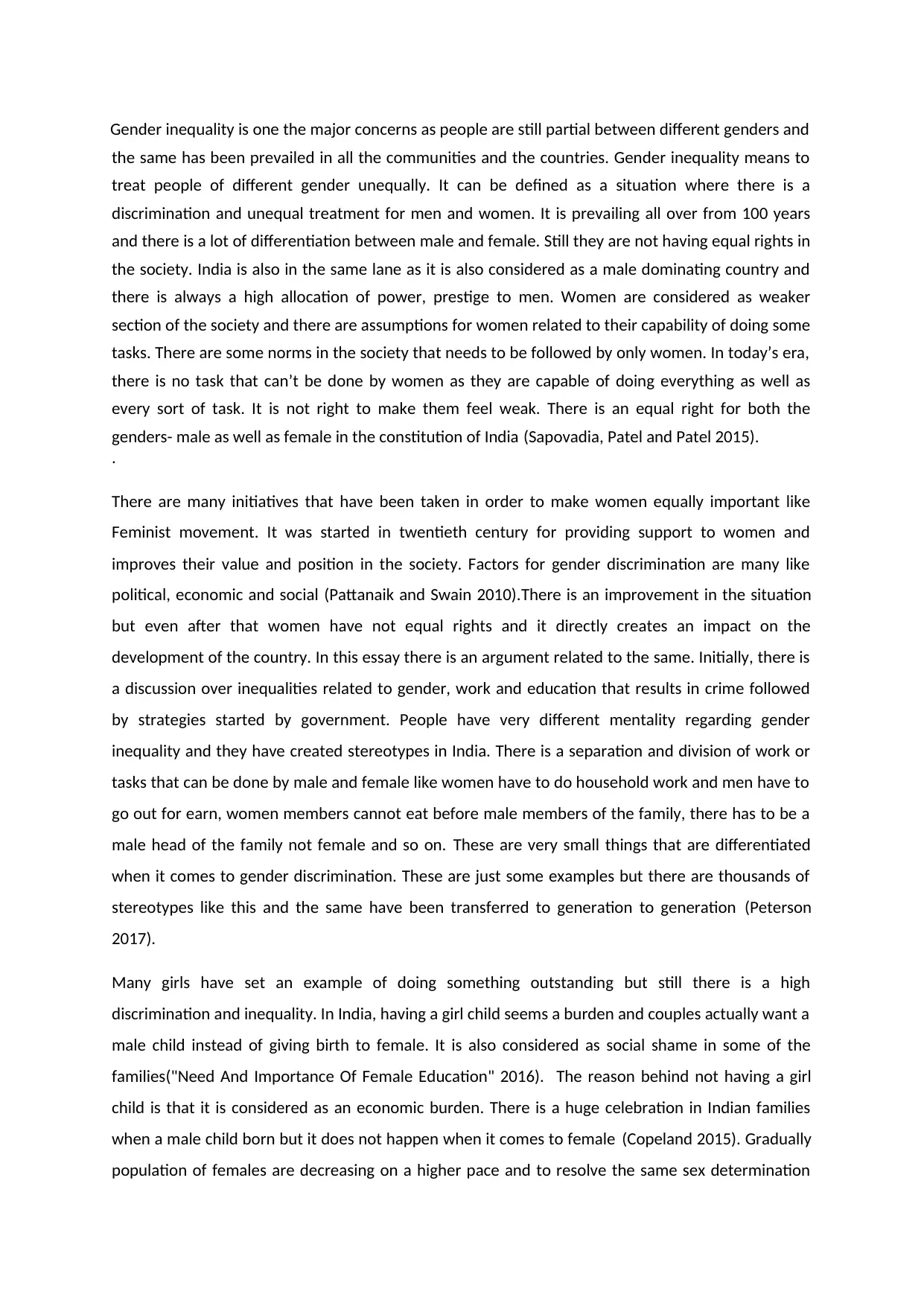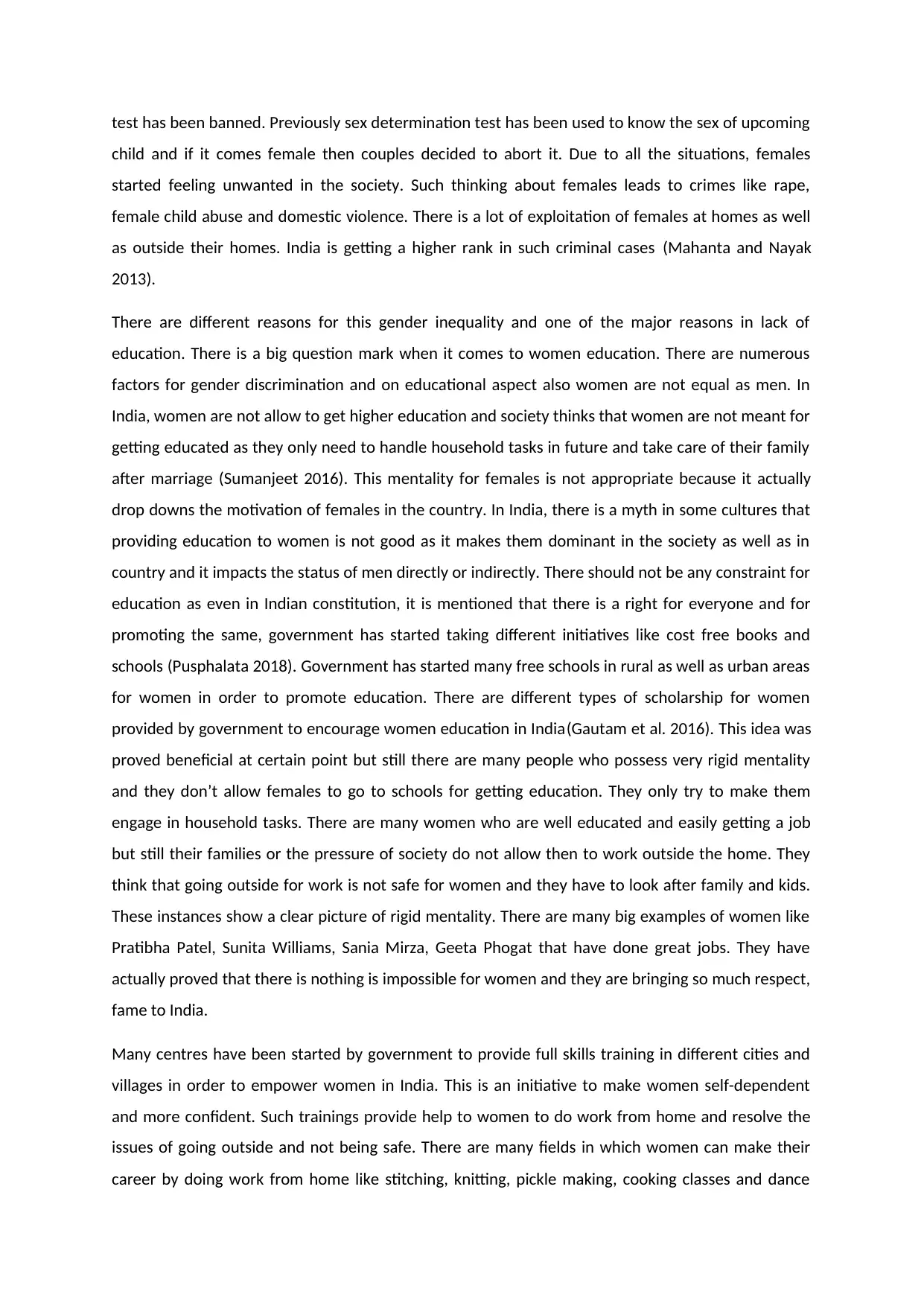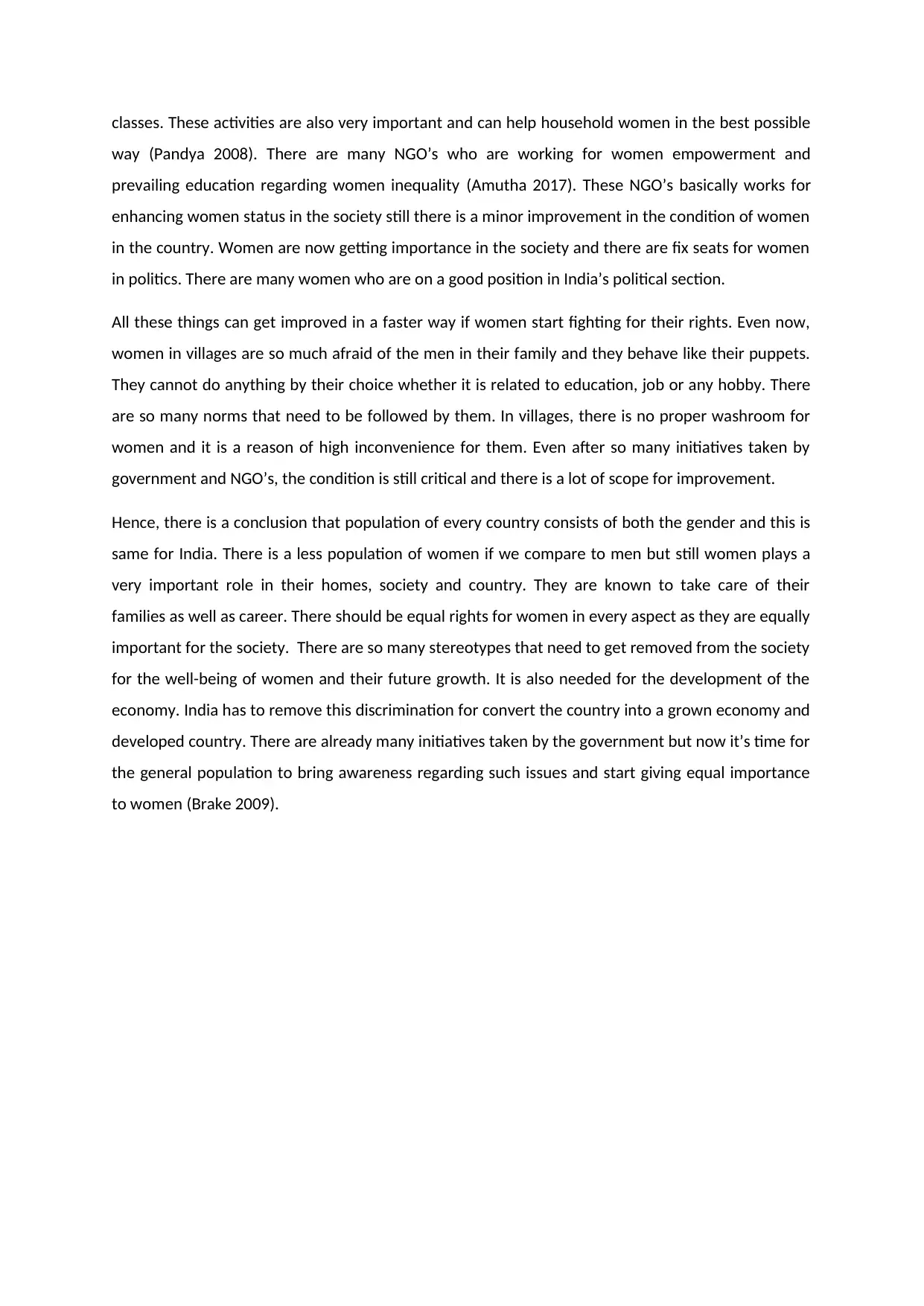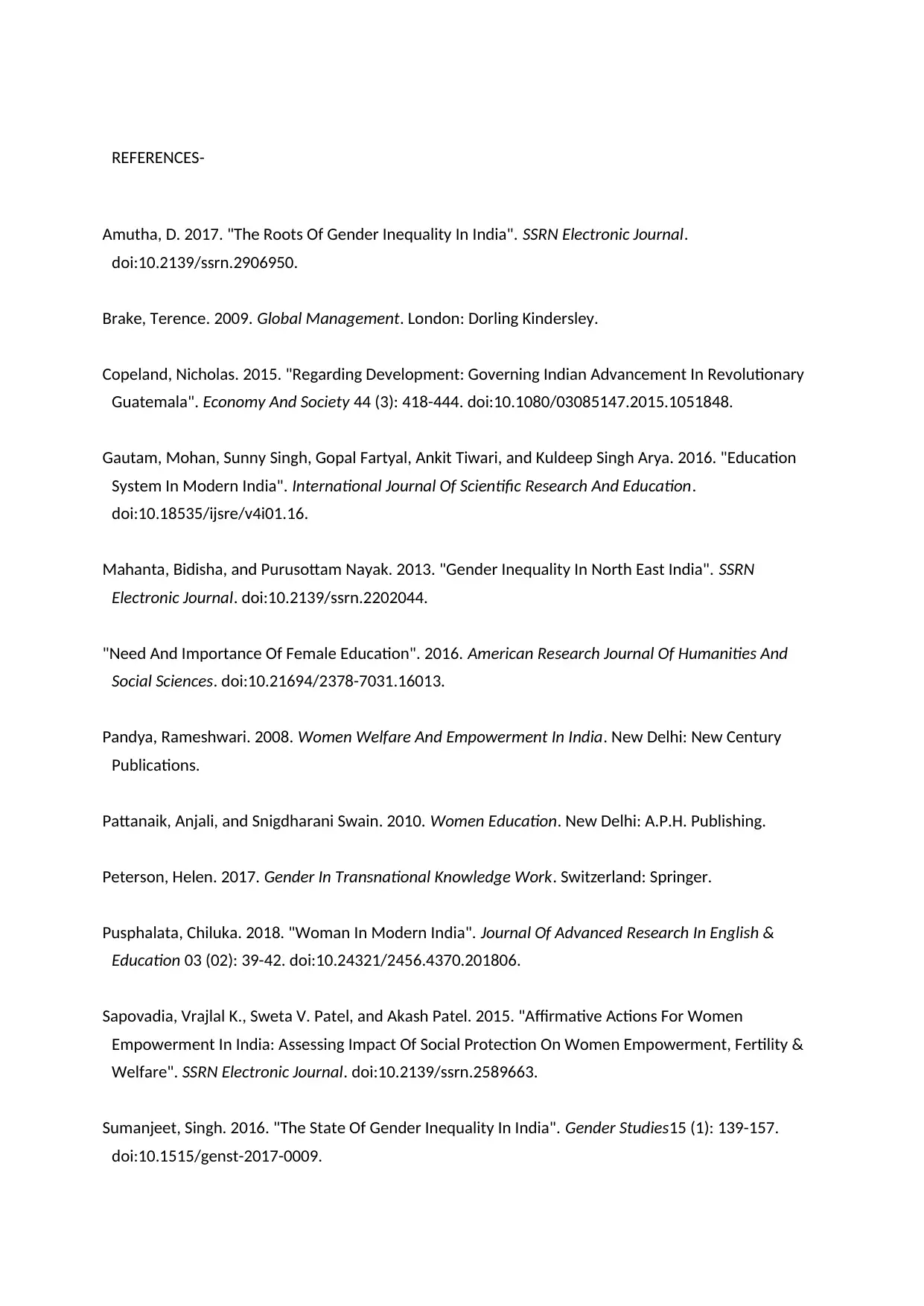TLC 501 : Communication skills
VerifiedAdded on 2021/09/12
|4
|1913
|77
AI Summary
Contribute Materials
Your contribution can guide someone’s learning journey. Share your
documents today.

Gender inequality is one the major concerns as people are still partial between different genders and
the same has been prevailed in all the communities and the countries. Gender inequality means to
treat people of different gender unequally. It can be defined as a situation where there is a
discrimination and unequal treatment for men and women. It is prevailing all over from 100 years
and there is a lot of differentiation between male and female. Still they are not having equal rights in
the society. India is also in the same lane as it is also considered as a male dominating country and
there is always a high allocation of power, prestige to men. Women are considered as weaker
section of the society and there are assumptions for women related to their capability of doing some
tasks. There are some norms in the society that needs to be followed by only women. In today’s era,
there is no task that can’t be done by women as they are capable of doing everything as well as
every sort of task. It is not right to make them feel weak. There is an equal right for both the
genders- male as well as female in the constitution of India (Sapovadia, Patel and Patel 2015).
.
There are many initiatives that have been taken in order to make women equally important like
Feminist movement. It was started in twentieth century for providing support to women and
improves their value and position in the society. Factors for gender discrimination are many like
political, economic and social (Pattanaik and Swain 2010).There is an improvement in the situation
but even after that women have not equal rights and it directly creates an impact on the
development of the country. In this essay there is an argument related to the same. Initially, there is
a discussion over inequalities related to gender, work and education that results in crime followed
by strategies started by government. People have very different mentality regarding gender
inequality and they have created stereotypes in India. There is a separation and division of work or
tasks that can be done by male and female like women have to do household work and men have to
go out for earn, women members cannot eat before male members of the family, there has to be a
male head of the family not female and so on. These are very small things that are differentiated
when it comes to gender discrimination. These are just some examples but there are thousands of
stereotypes like this and the same have been transferred to generation to generation (Peterson
2017).
Many girls have set an example of doing something outstanding but still there is a high
discrimination and inequality. In India, having a girl child seems a burden and couples actually want a
male child instead of giving birth to female. It is also considered as social shame in some of the
families("Need And Importance Of Female Education" 2016). The reason behind not having a girl
child is that it is considered as an economic burden. There is a huge celebration in Indian families
when a male child born but it does not happen when it comes to female (Copeland 2015). Gradually
population of females are decreasing on a higher pace and to resolve the same sex determination
the same has been prevailed in all the communities and the countries. Gender inequality means to
treat people of different gender unequally. It can be defined as a situation where there is a
discrimination and unequal treatment for men and women. It is prevailing all over from 100 years
and there is a lot of differentiation between male and female. Still they are not having equal rights in
the society. India is also in the same lane as it is also considered as a male dominating country and
there is always a high allocation of power, prestige to men. Women are considered as weaker
section of the society and there are assumptions for women related to their capability of doing some
tasks. There are some norms in the society that needs to be followed by only women. In today’s era,
there is no task that can’t be done by women as they are capable of doing everything as well as
every sort of task. It is not right to make them feel weak. There is an equal right for both the
genders- male as well as female in the constitution of India (Sapovadia, Patel and Patel 2015).
.
There are many initiatives that have been taken in order to make women equally important like
Feminist movement. It was started in twentieth century for providing support to women and
improves their value and position in the society. Factors for gender discrimination are many like
political, economic and social (Pattanaik and Swain 2010).There is an improvement in the situation
but even after that women have not equal rights and it directly creates an impact on the
development of the country. In this essay there is an argument related to the same. Initially, there is
a discussion over inequalities related to gender, work and education that results in crime followed
by strategies started by government. People have very different mentality regarding gender
inequality and they have created stereotypes in India. There is a separation and division of work or
tasks that can be done by male and female like women have to do household work and men have to
go out for earn, women members cannot eat before male members of the family, there has to be a
male head of the family not female and so on. These are very small things that are differentiated
when it comes to gender discrimination. These are just some examples but there are thousands of
stereotypes like this and the same have been transferred to generation to generation (Peterson
2017).
Many girls have set an example of doing something outstanding but still there is a high
discrimination and inequality. In India, having a girl child seems a burden and couples actually want a
male child instead of giving birth to female. It is also considered as social shame in some of the
families("Need And Importance Of Female Education" 2016). The reason behind not having a girl
child is that it is considered as an economic burden. There is a huge celebration in Indian families
when a male child born but it does not happen when it comes to female (Copeland 2015). Gradually
population of females are decreasing on a higher pace and to resolve the same sex determination
Secure Best Marks with AI Grader
Need help grading? Try our AI Grader for instant feedback on your assignments.

test has been banned. Previously sex determination test has been used to know the sex of upcoming
child and if it comes female then couples decided to abort it. Due to all the situations, females
started feeling unwanted in the society. Such thinking about females leads to crimes like rape,
female child abuse and domestic violence. There is a lot of exploitation of females at homes as well
as outside their homes. India is getting a higher rank in such criminal cases (Mahanta and Nayak
2013).
There are different reasons for this gender inequality and one of the major reasons in lack of
education. There is a big question mark when it comes to women education. There are numerous
factors for gender discrimination and on educational aspect also women are not equal as men. In
India, women are not allow to get higher education and society thinks that women are not meant for
getting educated as they only need to handle household tasks in future and take care of their family
after marriage (Sumanjeet 2016). This mentality for females is not appropriate because it actually
drop downs the motivation of females in the country. In India, there is a myth in some cultures that
providing education to women is not good as it makes them dominant in the society as well as in
country and it impacts the status of men directly or indirectly. There should not be any constraint for
education as even in Indian constitution, it is mentioned that there is a right for everyone and for
promoting the same, government has started taking different initiatives like cost free books and
schools (Pusphalata 2018). Government has started many free schools in rural as well as urban areas
for women in order to promote education. There are different types of scholarship for women
provided by government to encourage women education in India(Gautam et al. 2016). This idea was
proved beneficial at certain point but still there are many people who possess very rigid mentality
and they don’t allow females to go to schools for getting education. They only try to make them
engage in household tasks. There are many women who are well educated and easily getting a job
but still their families or the pressure of society do not allow then to work outside the home. They
think that going outside for work is not safe for women and they have to look after family and kids.
These instances show a clear picture of rigid mentality. There are many big examples of women like
Pratibha Patel, Sunita Williams, Sania Mirza, Geeta Phogat that have done great jobs. They have
actually proved that there is nothing is impossible for women and they are bringing so much respect,
fame to India.
Many centres have been started by government to provide full skills training in different cities and
villages in order to empower women in India. This is an initiative to make women self-dependent
and more confident. Such trainings provide help to women to do work from home and resolve the
issues of going outside and not being safe. There are many fields in which women can make their
career by doing work from home like stitching, knitting, pickle making, cooking classes and dance
child and if it comes female then couples decided to abort it. Due to all the situations, females
started feeling unwanted in the society. Such thinking about females leads to crimes like rape,
female child abuse and domestic violence. There is a lot of exploitation of females at homes as well
as outside their homes. India is getting a higher rank in such criminal cases (Mahanta and Nayak
2013).
There are different reasons for this gender inequality and one of the major reasons in lack of
education. There is a big question mark when it comes to women education. There are numerous
factors for gender discrimination and on educational aspect also women are not equal as men. In
India, women are not allow to get higher education and society thinks that women are not meant for
getting educated as they only need to handle household tasks in future and take care of their family
after marriage (Sumanjeet 2016). This mentality for females is not appropriate because it actually
drop downs the motivation of females in the country. In India, there is a myth in some cultures that
providing education to women is not good as it makes them dominant in the society as well as in
country and it impacts the status of men directly or indirectly. There should not be any constraint for
education as even in Indian constitution, it is mentioned that there is a right for everyone and for
promoting the same, government has started taking different initiatives like cost free books and
schools (Pusphalata 2018). Government has started many free schools in rural as well as urban areas
for women in order to promote education. There are different types of scholarship for women
provided by government to encourage women education in India(Gautam et al. 2016). This idea was
proved beneficial at certain point but still there are many people who possess very rigid mentality
and they don’t allow females to go to schools for getting education. They only try to make them
engage in household tasks. There are many women who are well educated and easily getting a job
but still their families or the pressure of society do not allow then to work outside the home. They
think that going outside for work is not safe for women and they have to look after family and kids.
These instances show a clear picture of rigid mentality. There are many big examples of women like
Pratibha Patel, Sunita Williams, Sania Mirza, Geeta Phogat that have done great jobs. They have
actually proved that there is nothing is impossible for women and they are bringing so much respect,
fame to India.
Many centres have been started by government to provide full skills training in different cities and
villages in order to empower women in India. This is an initiative to make women self-dependent
and more confident. Such trainings provide help to women to do work from home and resolve the
issues of going outside and not being safe. There are many fields in which women can make their
career by doing work from home like stitching, knitting, pickle making, cooking classes and dance

classes. These activities are also very important and can help household women in the best possible
way (Pandya 2008). There are many NGO’s who are working for women empowerment and
prevailing education regarding women inequality (Amutha 2017). These NGO’s basically works for
enhancing women status in the society still there is a minor improvement in the condition of women
in the country. Women are now getting importance in the society and there are fix seats for women
in politics. There are many women who are on a good position in India’s political section.
All these things can get improved in a faster way if women start fighting for their rights. Even now,
women in villages are so much afraid of the men in their family and they behave like their puppets.
They cannot do anything by their choice whether it is related to education, job or any hobby. There
are so many norms that need to be followed by them. In villages, there is no proper washroom for
women and it is a reason of high inconvenience for them. Even after so many initiatives taken by
government and NGO’s, the condition is still critical and there is a lot of scope for improvement.
Hence, there is a conclusion that population of every country consists of both the gender and this is
same for India. There is a less population of women if we compare to men but still women plays a
very important role in their homes, society and country. They are known to take care of their
families as well as career. There should be equal rights for women in every aspect as they are equally
important for the society. There are so many stereotypes that need to get removed from the society
for the well-being of women and their future growth. It is also needed for the development of the
economy. India has to remove this discrimination for convert the country into a grown economy and
developed country. There are already many initiatives taken by the government but now it’s time for
the general population to bring awareness regarding such issues and start giving equal importance
to women (Brake 2009).
way (Pandya 2008). There are many NGO’s who are working for women empowerment and
prevailing education regarding women inequality (Amutha 2017). These NGO’s basically works for
enhancing women status in the society still there is a minor improvement in the condition of women
in the country. Women are now getting importance in the society and there are fix seats for women
in politics. There are many women who are on a good position in India’s political section.
All these things can get improved in a faster way if women start fighting for their rights. Even now,
women in villages are so much afraid of the men in their family and they behave like their puppets.
They cannot do anything by their choice whether it is related to education, job or any hobby. There
are so many norms that need to be followed by them. In villages, there is no proper washroom for
women and it is a reason of high inconvenience for them. Even after so many initiatives taken by
government and NGO’s, the condition is still critical and there is a lot of scope for improvement.
Hence, there is a conclusion that population of every country consists of both the gender and this is
same for India. There is a less population of women if we compare to men but still women plays a
very important role in their homes, society and country. They are known to take care of their
families as well as career. There should be equal rights for women in every aspect as they are equally
important for the society. There are so many stereotypes that need to get removed from the society
for the well-being of women and their future growth. It is also needed for the development of the
economy. India has to remove this discrimination for convert the country into a grown economy and
developed country. There are already many initiatives taken by the government but now it’s time for
the general population to bring awareness regarding such issues and start giving equal importance
to women (Brake 2009).

REFERENCES-
Amutha, D. 2017. "The Roots Of Gender Inequality In India". SSRN Electronic Journal.
doi:10.2139/ssrn.2906950.
Brake, Terence. 2009. Global Management. London: Dorling Kindersley.
Copeland, Nicholas. 2015. "Regarding Development: Governing Indian Advancement In Revolutionary
Guatemala". Economy And Society 44 (3): 418-444. doi:10.1080/03085147.2015.1051848.
Gautam, Mohan, Sunny Singh, Gopal Fartyal, Ankit Tiwari, and Kuldeep Singh Arya. 2016. "Education
System In Modern India". International Journal Of Scientific Research And Education.
doi:10.18535/ijsre/v4i01.16.
Mahanta, Bidisha, and Purusottam Nayak. 2013. "Gender Inequality In North East India". SSRN
Electronic Journal. doi:10.2139/ssrn.2202044.
"Need And Importance Of Female Education". 2016. American Research Journal Of Humanities And
Social Sciences. doi:10.21694/2378-7031.16013.
Pandya, Rameshwari. 2008. Women Welfare And Empowerment In India. New Delhi: New Century
Publications.
Pattanaik, Anjali, and Snigdharani Swain. 2010. Women Education. New Delhi: A.P.H. Publishing.
Peterson, Helen. 2017. Gender In Transnational Knowledge Work. Switzerland: Springer.
Pusphalata, Chiluka. 2018. "Woman In Modern India". Journal Of Advanced Research In English &
Education 03 (02): 39-42. doi:10.24321/2456.4370.201806.
Sapovadia, Vrajlal K., Sweta V. Patel, and Akash Patel. 2015. "Affirmative Actions For Women
Empowerment In India: Assessing Impact Of Social Protection On Women Empowerment, Fertility &
Welfare". SSRN Electronic Journal. doi:10.2139/ssrn.2589663.
Sumanjeet, Singh. 2016. "The State Of Gender Inequality In India". Gender Studies15 (1): 139-157.
doi:10.1515/genst-2017-0009.
Amutha, D. 2017. "The Roots Of Gender Inequality In India". SSRN Electronic Journal.
doi:10.2139/ssrn.2906950.
Brake, Terence. 2009. Global Management. London: Dorling Kindersley.
Copeland, Nicholas. 2015. "Regarding Development: Governing Indian Advancement In Revolutionary
Guatemala". Economy And Society 44 (3): 418-444. doi:10.1080/03085147.2015.1051848.
Gautam, Mohan, Sunny Singh, Gopal Fartyal, Ankit Tiwari, and Kuldeep Singh Arya. 2016. "Education
System In Modern India". International Journal Of Scientific Research And Education.
doi:10.18535/ijsre/v4i01.16.
Mahanta, Bidisha, and Purusottam Nayak. 2013. "Gender Inequality In North East India". SSRN
Electronic Journal. doi:10.2139/ssrn.2202044.
"Need And Importance Of Female Education". 2016. American Research Journal Of Humanities And
Social Sciences. doi:10.21694/2378-7031.16013.
Pandya, Rameshwari. 2008. Women Welfare And Empowerment In India. New Delhi: New Century
Publications.
Pattanaik, Anjali, and Snigdharani Swain. 2010. Women Education. New Delhi: A.P.H. Publishing.
Peterson, Helen. 2017. Gender In Transnational Knowledge Work. Switzerland: Springer.
Pusphalata, Chiluka. 2018. "Woman In Modern India". Journal Of Advanced Research In English &
Education 03 (02): 39-42. doi:10.24321/2456.4370.201806.
Sapovadia, Vrajlal K., Sweta V. Patel, and Akash Patel. 2015. "Affirmative Actions For Women
Empowerment In India: Assessing Impact Of Social Protection On Women Empowerment, Fertility &
Welfare". SSRN Electronic Journal. doi:10.2139/ssrn.2589663.
Sumanjeet, Singh. 2016. "The State Of Gender Inequality In India". Gender Studies15 (1): 139-157.
doi:10.1515/genst-2017-0009.
1 out of 4
Related Documents
Your All-in-One AI-Powered Toolkit for Academic Success.
+13062052269
info@desklib.com
Available 24*7 on WhatsApp / Email
![[object Object]](/_next/static/media/star-bottom.7253800d.svg)
Unlock your academic potential
© 2024 | Zucol Services PVT LTD | All rights reserved.




